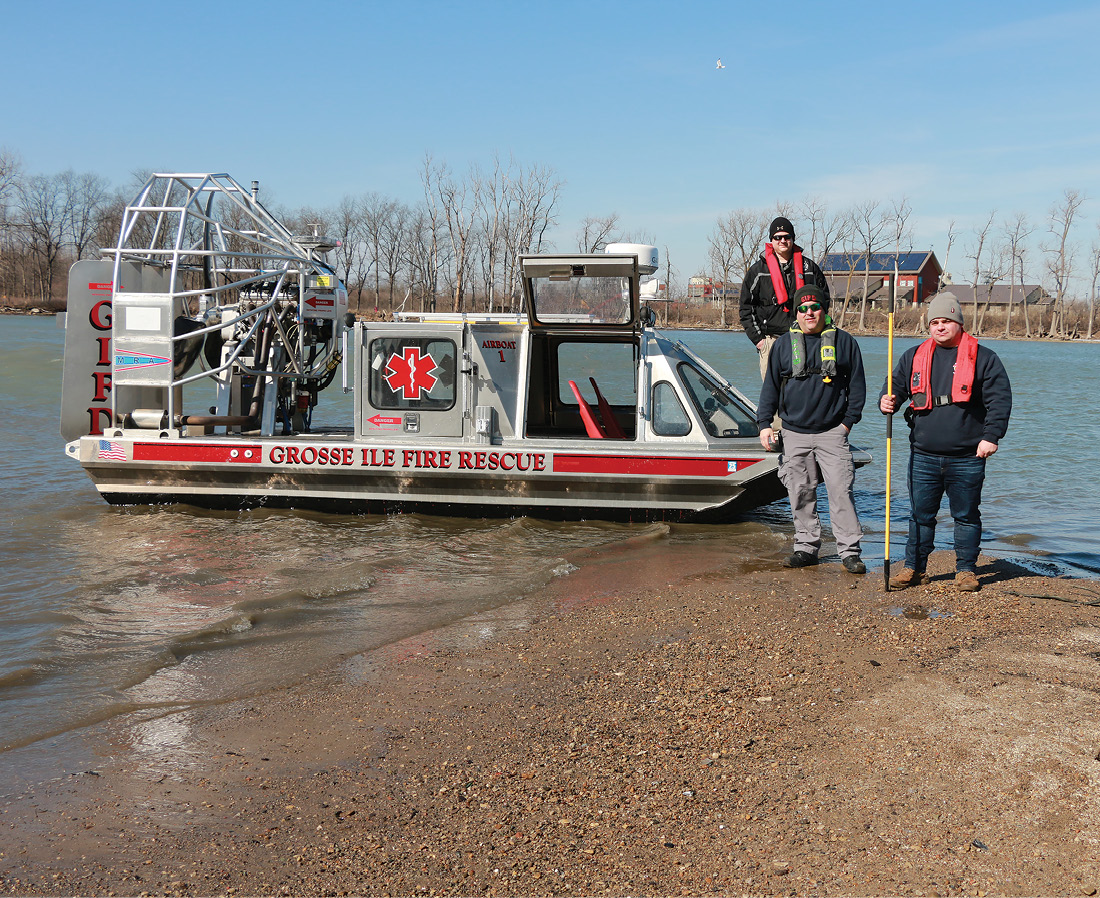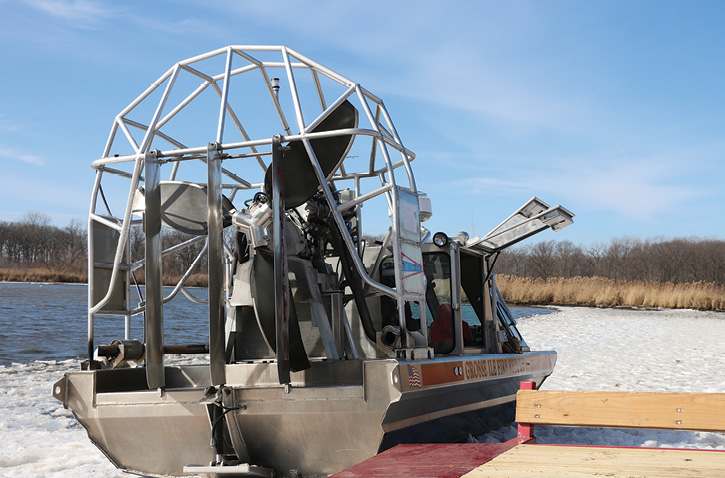By Constance York
Twenty miles downriver of Detroit and sitting at the base of Lake Erie is the small island community of Grosse Ile, Michigan—population just over 10,000. It’s a wealthy community, by comparison, to its mainland neighboring cities, and its fire department isn’t the busiest. However, what it lacks in run volume, it makes up for with potential scenarios and possible limitations, simply by the uniqueness of the island. “We’re all on-call, we have a pager system,” says Firefighter Jake Gonzalez. “We have a chief and fire marshal who stay in the station throughout the week, Monday through Friday, 8 to 4. Then when a call comes out, we all get paged either by cell phone or pager. If it’s a water rescue, we all come directly here. Sometimes we’ll utilize a boat that we have out on the East River.”
Grosse Ile is connected to the mainland by two swing truss bridges. Each bridge crosses the Trenton Channel on the west side of the island. On the north end of the island is a toll bridge, and at the south end is a free, county-owned bridge. Both bridges have been out of service at times for months. In 1992, the toll bridge was hit by a freighter and was out of service for about four months. More recently, the free bridge was closed for 18 months because of unplanned emergency structural repairs.
The Grosse Ile (MI) Fire Department (GIFD) has to plan for different ways to transport victims to mainland hospitals and use water transport if need be. There is no hospital on the island. The closest hospital at the south end would be about four miles from the free bridge and about seven miles from the toll bridge, and that’s just from the bridges themselves and just the south end. If the call is at the north end, there is another hospital on the mainland there. So, just deciding which hospital and how to transport becomes part of the training and response.
GIFD responds to 11 islands, portions of the Detroit River, Lake Erie, and portions of the Livingstone Channel. Depending on the call or location, water transport to a waiting ambulance at a boat launch can be the fastest way to transport a victim. “We have a jump bag. It has all of our medical equipment,” says Firefighter Marino Moccia. “Depending on the mission, we’ll try and keep as much medical equipment as we can, while keeping in mind the weight limit.”

1 Air 1, in service with the Grosse Ile (MI) Fire Department, is a 2006 Midwest Rescue Airboats unit with a 625-horsepower engine. (Photos by author.)

2 Air 1 goes at its fastest speeds when driven across ice, but it also operates well in water—even if very shallow—and on snow- and ice-covered land.
Freighters heading to Detroit or further north emerge from Lake Erie and take the deep Livingstone Channel until they arrive at the north end of the island and upward into the main Detroit River. To the south and facing Lake Erie is the Grosse Ile Airport on the grounds of a former Naval base. It operated from 1927 to 1969. During World War II, it was a primary training center for Navy pilots. “A plane going in the water would be a pretty significant process,” says Gonzalez. “You’d get [the] Coast Guard, Wayne County sheriffs, and there would be a big mutual-aid effort.”
While Grosse Ile is only about 10 square miles, not including water, it is the largest island in the Detroit River. Two of the closest islands—Sugar and Celeron—are frequent stops for boaters to spend the day. In 2020, a jet skier crashed into a rock wall at a high rate of speed near Stoney Island. One inlet among the small islands is Dunbar Cove, which was once connected to the mainland by a railroad crossing and still holds remnants of industrial usage from the past. “We’re all boaters,” says Gonzalez. “In the summertime, a lot of us are already in the water and can utilize our own boats.”
Grosse Ile also is home to five boat marinas, a small downtown area, as well as normal community buildings and schools. The area is somewhat rural and wooded, with homes ranging from small and modest to multimillion-dollar mansions. The possible calls for GIFD could include boating and jet-ski accidents, drownings, stranded ice-fisherman or duck hunters, airplane or helicopter crashes, cars in the water, as well as normal fires and medical runs. “Pretty much every structure fire now gets a mutual aid call out,” said Moccia. Downriver mutual aid consists of 18 communities and the Wayne County Airport. “Downriver” refers to communities downriver from Detroit or down the Detroit River. Nearby cities also do water rescues, but they don’t have as much equipment as Grosse Ile. “We’re the go-to for water rescue,” says Gonzalez.
STAYING PREPARED
To stay prepared, the department frequently trains. For example, on a cold, sunny February day, firefighters trained with the department’s airboat along islands in Lake Erie and along the Detroit River Wildlife Refuge. Purchased in 2006, the airboat has a 625-horsepower engine and was manufactured by Midwest Rescue Airboats. It goes at its fastest speeds when driven across ice, but it also operates well in water—even if very shallow—and on snow- and ice-covered land.
On dry land, it can become grounded or stuck on small logs and debris, so they trained for what to do in that event. The boat was redesigned with a special trim tab that can help maneuver the boat back into water or onto ice. “We train more than we actually use the airboat,”says Firefighter Andrew Huber. “The waters, as of late, haven’t freezed up.” Operators use headphones so they can communicate over the airboat’s loud engine noise. Special suits are worn that can be used as flotation devices. “We have more involved suits than this where they are all enclosed and encapsulated so we can crawl across the water, get in the water, and float,” says Gonzalez. If it’s close to shore, the department has a skid rescuers can drag across ice to reach victims. “A lot of times when we get called for an ice water rescue, people will go out and try to help somebody, and then we have multiple victims because they may not be equipped or prepared,” Moccia says. “The person going out to try and rescue someone with the best of intentions now also becomes a victim. We get deployed for one person, but we get there and might find out there are actually two or three people who now need rescue.”
Grosse Ile (MI) Fire Department
Twenty firefighting personnel operate two BLS ambulances, three pumpers, one rescue-pumper, one ladder truck, an aluminum watercraft, an inflatable watercraft, an airboat, a fire boat, a utility truck, a command vehicle, and a fire marshal vehicle.
The department also has two other boats that it uses, and in summer would use those over the airboat for a variety of reasons—easier to transport patients, hold more equipment, and would reach a destination quicker. “We’re limited by weight,” Moccia says. “What we get dispatched for is not always what we get. We try and stay within four or five people responding on water rescues in case we need to transport victims,” he says. “We may get to a scene and have to pick up two or three people. We try and get back to shore as quickly as possible so we can transport.”
At one incident in August 2020, the department responded to a single vessel that crashed in the river between Fox and Sugar Islands. The GIFD deployed water rescue equipment and, along with the Downriver Mutual Aid Dive Team, rescued five children and seven adults. Two other adults drowned, and their bodies were recovered a few days later. Canine teams were also used for that rescue.
Moccia has a trained search and rescue (SAR) dog that he uses for the department as well as for volunteer SAR throughout Michigan. His dog is specially trained to find corpses. The GIFD performs three to four recoveries a year after people drown up river and end up along the shores of islands near and on Grosse Ile. Moccia says because his dog is trained to recover corpses, one boat is used for that purpose and the other one never is. “We don’t do any type of body recovery with the aluminum boat. We try and keep this boat as clean as we can,” he says, “so the dog has a sterile work environment.”
He adds, “The bow of the boat can come down so it can kind of roll into the water to retrieve people.” The Detroit River is known to have a swift current that can be easily underestimated. Knowing the waters around this island system is clearly beneficial to Grosse Ile firefighters.
CONSTANCE YORK is a multimedia journalist from the Detroit, Michigan, area. She is best known in the fire service for her work documenting the Detroit (MI) Fire Department in the Detroit on Fire series and The 25 Year War—PTSD in the Fire Department.

